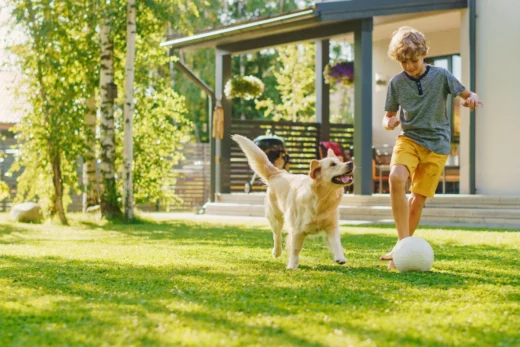
Have you noticed your puppy behaving differently? They were once the cutest puppy in the world, even after waking you up at 3 am to be let outside to go potty. But now it seems like you’ve got a little shark on your hands. They’re tearing up whatever they can get at, whether it be your shoes, books, or your hands.
But what causes this sudden chewing and nipping? Don’t worry, your dog isn’t being aggressive; they’re just teething.
Puppy teething can be frustrating, as it can lead to your furniture, hobbies, and skin being chewed up. But, as with most other puppy worries, others before you have been through it and lived to tell the tale. That means you and your puppy will get through teething with no issue. And the two of you can handle puppy teething with ease. Whether it’s treats for puppies or bite inhibition, you can work with your puppy to redirect their teething towards safer objects – all while instilling positive behaviors.
But first, you’ll need to understand what puppy teething is – what it looks like, and potential dental warning signs that may just be normal.

What Is Teething?
Just like humans, puppies eventually lose their baby teeth, with their adult teeth growing in their place. It’s a necessary part of growing up – while they might not get the fun of the tooth fairy, like you did, it’s a simple sign they’re aging out of puppyhood. Complications can still happen during this process, such as teeth not growing in correctly or inflamed gums, but the same happens in humans. It’s all part of the process!
The process where your puppy’s adult teeth start growing in is called teething. Their adult teeth begin pushing their way through the gums, out to the surface, filling the space their baby teeth left in their wake. While it’s a natural process, it’s also uncomfortable. You probably don’t remember it, but your parents might have given you a popsicle to calm your gums while your adult teeth were growing in. It was cold and comforting. It made your gums feel soothed, and the pain wasn’t as bad.
Your puppy is going through the exact same thing. They are going to have gum pain, so they turn to chewing. It seems antithetical, in practice, but it helps them soothe discomfort.
When and Why Do Puppies Start Teething?
The process of teething is a gradual one, although it may appear to be sudden. Puppies start getting their baby teeth after just a week or two of age, although they won’t be fully out until a month or so after their birth. These are often referred to as “milk teeth,” as their teeth come in while they are still nursing on their mother – hence, having little need for their teeth. All 28 of their baby teeth should have fully emerged by the time they are a month and a half old.

But then the trouble begins. Your puppy will begin teething between the ages of four to five months old. You may notice a few of your puppy’s teeth around the house, either stuck in toys or just lying in the kitchen, but you may not. Puppies tend to swallow their teeth, due to them falling out while eating or chewing on something. This is completely safe and is not harmful for your puppy.
This is the time when teething begins.
After their teeth fall out, their adult teeth will begin growing in. That state of growth can be painful for a puppy. Most of all, it’s uncomfortable. To overcome that discomfort, your puppy is going to begin gnawing on various things around them. That gnawing and chewing is comforting on their gums, as it acts like both a stress reliever and a massage for their sore gums.
They’ll continue teething as their adult teeth – all 42 of them – grow in, which can last until they are one year old. That sounds like a long time to deal with puppy teething, but it’s not bad as long as you’re on top of things.
But what exactly does teething look like, besides gnawing and chewing?





